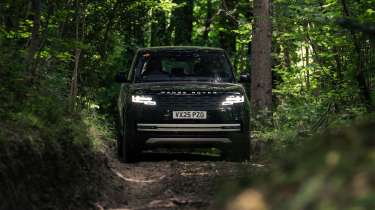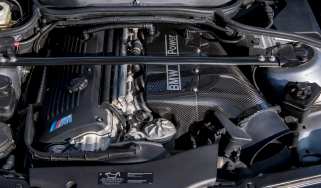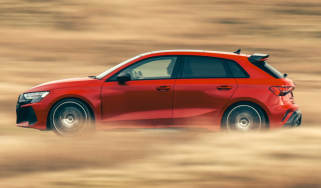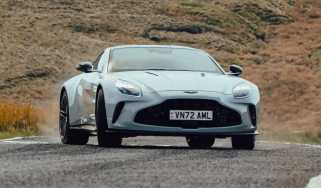The Range Rover Electric is the quietest, most refined version ever – and we’ve driven it
The Range Rover is going electric, with the promise of an even more seamless and refined drive. We get behind the wheel of a prototype off road
It was going to happen sooner or later, wasn’t it? The first all-electric Range Rover is coming this year, and though the high-end EV market has been a tough nut to crack for some manufacturers, Range Rover is convinced that it’ll be a success. ‘We listened to what our customers want’, said Simon Fairbrother, Range Rover Electric Programme Chief. ‘The overwhelming response was, first and foremost, it needs to be a Range Rover. Don’t change it, just make it better. We will, and we have to, make it perfect.’ Ahead of its official launch, we got a small taste of what’s to come by getting behind the wheel of a prototype at Land Rover’s Eastnor testing centre.
Before that, some background. Range Rover’s approach to building an EV couldn’t be more different to Jaguar’s just across the hall in Coventry. Jaguar is going unashamedly bold – to the point of being unrecognisable – in a bid to entice new customers, but the Range Rover EV flies completely under the radar. If it wasn’t for the flash of green on its number plate you wouldn’t know it was battery powered, although the keen-eyed will spot a blanked-off grille and low-drag aero wheels when the production version lands. Range Rover’s approach to EVs is about giving buyers a choice of powertrain to suit their lives, rather than forcing them down a certain path – hence why petrol, diesel and PHEV models will continue to be sold alongside the Electric, and the latest Range Rover was designed from the outset to accommodate all types of powertrain.
The Range Rover’s MLA platform is 76 per cent aluminium, with the EV gaining an 800-volt electronic architecture and an enormous 118kWh floor-mounted battery, powering an electric motor on each axle. Maximum range is quoted at over 300 miles, while the front and rear motors are identical for an even power split, and are said to offer similar performance to the 523bhp Range Rover P530, which gets to 62mph in 4.4sec. Those numbers won’t trouble a Tesla Model X Plaid, but the Range Rover has never been a car for drag racing on YouTube.
More reviews
In-depth reviews
- Range Rover 2025 review – there’s no need to go electric
- Range Rover review (L405, 2012-2021) – verdict, specs and rivals
- Range Rover Sport review
Long term tests
Reviews
Instead, comfort, refinement and off-road ability have been the key areas of development. To this end, the battery helps stiffen the shell (although it isn’t integral to the structure), the electric motors are of course near silent, and the acoustics of the Electric have necessitated bespoke insulation to keep the cabin as quiet as possible. There is, however, the small matter of weight to contend with. Range Rover won’t disclose an exact figure, but the Electric will no doubt be a heavier beast than ICE models. A scary thought when the mild-hybrid P530 comes in at 2585kg…
With that said, the floor-mounted battery means the mass is concentrated lower in the car, which has negated the need for active anti-roll bars to minimise roll. Instead, softer fixed roll bars are used that allow for the required levels of wheel articulation off road. Not something we’ll be putting to the test on Range Rover’s test route – a tight, undulating forest pass that doesn’t push the car to its absolute limit, but gives a sense of the Electric’s ride quality and refinement, plus the calibration of its powertrain and torque management systems on a low-traction surface.
Our transfer to the course is in a plug-in hybrid Range Rover, an extremely quiet car by any measure, but the Electric immediately feels even more together and tightly insulated. Our impressions are confined to very low speed driving, but even so, you’re a little more isolated from ripples in the surface, with finer vibrations and noise filtered out even more effectively. It’s a good start.
The Electric rides on retuned suspension, comprising two-chamber air springs and adaptive dampers, but the all-season tyres we’re driving on aren’t an EV-specific compound. This, says Range Rover, was important for a more seamless ownership experience, without the need to seek out specially-designed rubber when it’s time to swap. Surprisingly, the Electric also doesn’t have a locking differential on either the front or rear axles. Instead it uses the precise torque delivery from the motors to manage traction, while applying the brakes on unloaded wheels to transfer torque to the opposite side. On the slipperiest uphill sections you can feel the system nipping away at the wheels to find grip. Why not go for a Mercedes G580-style quad motor system for precise control of all four wheels? ‘We can deliver all the attributes we need for a Range Rover with the twin-motor solution,’ says Fairbrother. We didn’t get stuck so perhaps that’s fair enough, but you’ve got to assume that four motors would offer a higher ceiling of capability.
The floor-mounted battery also reduces the ground clearance by a 30 millimetres – we lightly grazed the underbody a couple of times during our test – but the unit is shielded against knocks and scrapes. An 850mm wading depth also falls 50mm short of the petrol model, matching the Range Rover Sport. By and large, though, the Range Rover Electric strolls through the course with very little effort, the light control weights and rear-axle steering making it easy to swing around tight turns and the torque delivery being smooth and progressive. The brakes are easy to modulate at low speed too, although the one-pedal driving option doesn’t feel especially intuitive off-road. On downhill slopes you sometimes need to consciously apply the throttle to keep moving rather than letting the car roll, which doesn’t feel natural.
Look around the cabin and all is as it should be – no lumps in the floor, no raised footwells and no compromises in practicality. The boot is unchanged too, and this could be an electric car that isn’t hopeless at towing. It can officially pull 2.5 tons, and the range prediction can take into account whatever it is you’re towing. How much range will actually be left is another matter, of course.
After this very brief taste, the signs are positive for the Range Rover Electric. It’s set to be one of the most luxurious, refined and versatile vehicles of its type, as a Range Rover should be. The bigger question is whether enough customers want a Range Rover powered by batteries. The company says that over 64,000 clients have signed up to the waiting list – let’s see how many actually take the plunge.





